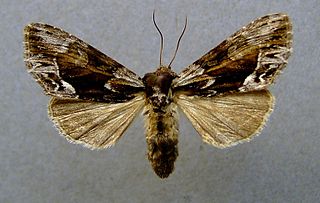
Apamea crenata, known as the clouded-bordered brindle, is a moth in the family Noctuidae. It is distributed throughout the Palearctic realm. In the North it crosses the Arctic Circle, in the Mediterranean it is found only in cool locations and mountains avoiding very hot areas. In the Alps, it rises to an altitude of about 2000 metres.

Mesapamea secalis, the common rustic, is a moth of the family Noctuidae. The species was first described by Carl Linnaeus in his 1758 10th edition of Systema Naturae. It is found in Europe, north-west Africa, Turkey and northern Iran.

Grammodes stolida, the geometrician, is a moth of the family Erebidae. The species was first described by Johan Christian Fabricius in 1775. It is found in Africa, southern Europe, most of Asia and Australia. It migrates to central and northern Europe as far north as England, Denmark and Finland.

Leucania loreyi, the cosmopolitan, false army worm or nightfeeding rice armyworm, is a moth of the family Noctuidae. It is found in most of African countries, the Indo-Australian subtropics and tropics of India, Sri Lanka, Myanmar, the eastern Palearctic realm, and the Near East and Middle East. The species was first described by Philogène Auguste Joseph Duponchel in 1827.

Xylena vetusta, the red sword-grass, is a moth of the family Noctuidae. The species was first described by Jacob Hübner in 1813. It is found in the Palearctic realm from northwestern Africa through Europe and Asia up to central Siberia. In the north it is found up to the Arctic Circle and Iceland.

Hyppa rectilinea, the Saxon, is a moth of the family Noctuidae. It is found in Europe, but mostly in northern and central Europe. In the south, it is found in scattered populations, mainly in mountainous areas. To the east, its range stretches through northern Asia and eastern Siberia, up to the Pacific Ocean and Japan.

Apamea oblonga, the crescent striped, is a moth of the family Noctuidae. The species was first described by Adrian Hardy Haworth in 1809. It is found in northern and central Europe, east to southern Russia, Asia Minor, Armenia, Turkestan, Turkey, Iran, southern Siberia, northern Pakistan, Mongolia, China, Sakhalin and Japan
Ypsolopha delicatella is a moth of the family Ypsolophidae. It is known from the United States, including Arizona and California.
Hypatima euplecta is a species of moth in the family Gelechiidae. It was described by Edward Meyrick in 1904. It is found in Australia, where it has been recorded from Queensland, New South Wales, Victoria and South Australia.
Coleotechnites condignella is a moth of the family Gelechiidae. It is found in North America, where it has been recorded from California, Arizona, South Carolina and Florida.
Sophronia roseicrinella is a moth of the family Gelechiidae. It was described by August Busck in 1909. It is found in North America, where it has been recorded Texas.
Battaristis bistrigella is a moth of the family Gelechiidae. It was described by August Busck in 1914. It is found in Panama.
Aristotelia penicillata is a moth of the family Gelechiidae. It was described by Walsingham in 1897. It is found in West Indies, where it has been recorded from Haiti.
Dorycnopa triphera is a moth of the family Gelechiidae. It was described by Oswald Bertram Lower in 1920. It is found in Australia, where it has been recorded from South Australia.
Chlamydastis ommatopa is a moth of the family Depressariidae. It is found in Colombia and Bolivia.
Antaeotricha bicolor is a species of moth of the family Depressariidae. It is found in Brazil.
Psittacastis incisa is a moth in the family Depressariidae. It was described by Lord Walsingham in 1912. It is found in Mexico (Tabasco) and Panama.
Eupselia melanostrepta is a moth in the family Depressariidae. It was described by Edward Meyrick in 1880, where it has been recorded from Victoria and Tasmania.
Antaeotricha trisinuata is a moth in the family Depressariidae. It was described by Edward Meyrick in 1930. It is found in Brazil.
Stenoma symmicta is a moth in the family Depressariidae. It was described by Lord Walsingham in 1913. It is found in Panama and Guyana.






